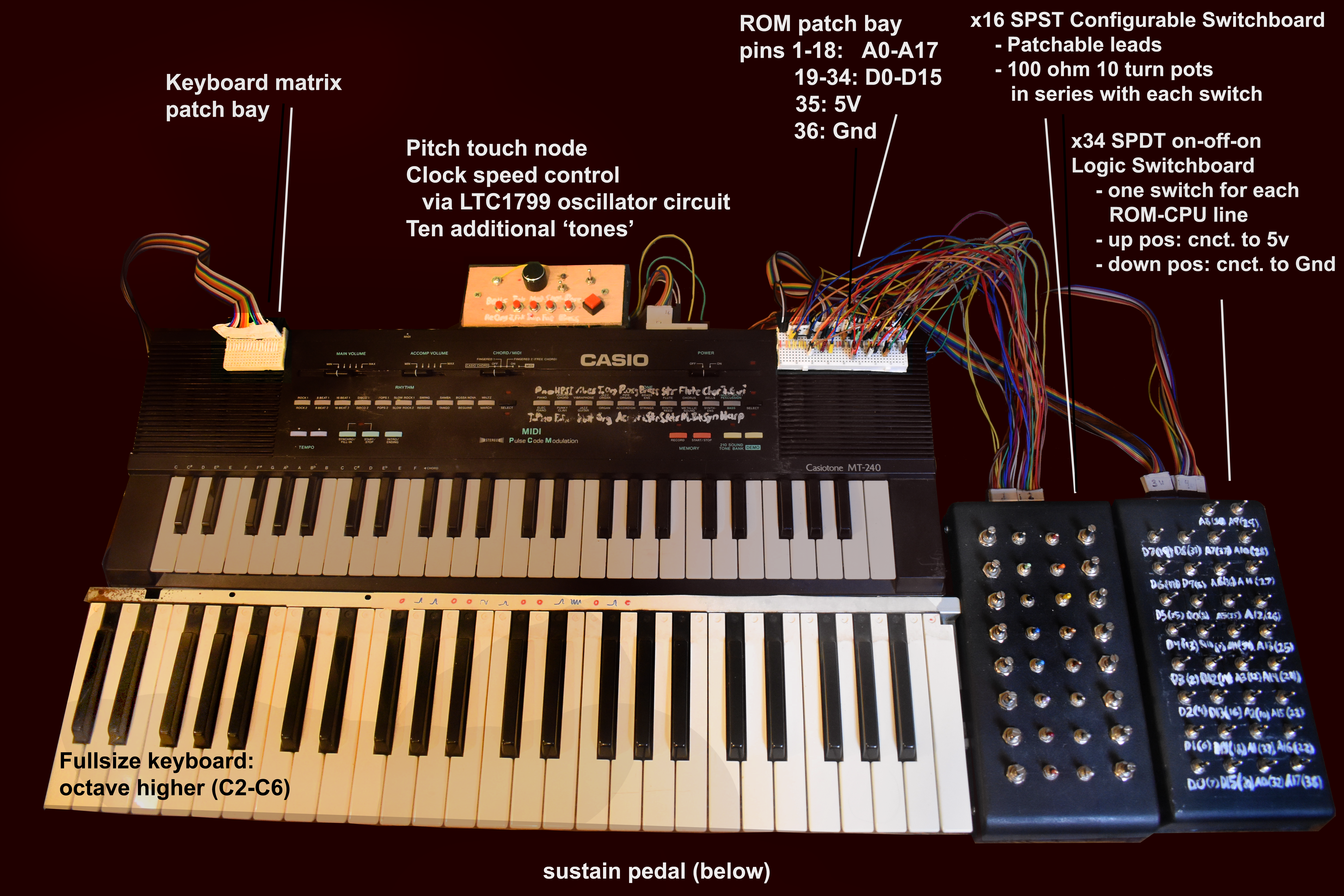

Breadboard patch bay
Configuarable switchboard
Logic switchboard
Aux patch bay & controller
Keyboard patch bay & big keyboard
The 34 pins of the ROM chip are wired to individual rows on an externally mounted breadboard. The breadboard in this configuration serves as a patch bay: jumpering two rows together connects the corresponding ROM pins together. The great advantages of this system are being able to explore the effects of different combinations of ROM pins without hardwiring them, and being able to easily recall effects by patching in the right combination.
Data across two connected ROM pins becomes superimposed, suppressing certain high logic signals, changing the synthesis program, ultimately causing an effect on the sound produced. This affects the sound produced when a key is pressed, and changes things like adsr, timbre, pitch, scale, tremolo, etc, depending on which ROM pins are connected, as well as the 'TONE' preset active (ie 'Piano' or 'Harp').
A switch connected to a pair of wires can be used to conveniently patch-in and activate a ROM pin combination. Connect the pair of wires to two breadboard rows, and the ROM pin combination is now controlled by the switch. With 16 of these switches, complex patches can be built with arrangements of combinations.
In series with each switch is also a potentiometer knob. These 100 ohm 10 turn variable resistors let you fine-tune to the right amount of resistance between the ROM pins for stable, consistent function. If the resistance isn't right, the effect becomes unstable: it might have unanticipated side effects or fluctuate randomly between two states. This is normally undesirable, as it can produce an unwanted sound or cause a soft-lock, but it can also be used as an element of aleatory. If a sound is fluctuating between the two interesting states, very minute changes in resistance causes a greater likelihood of one state or the other.
This second switchboard is not configurable, each of the 34 switches are hardwired to each pin on the ROM chip, through each row on the breadboard. These switches also have two 'on' positions, up-position or down-position, from a neutral 'off' position. The up-position connects the ROM pin to 5V DC, and the down-position connects the ROM pin to Gnd (0V). This forces the ROM pin to a logic high (1) state or logic low (0) state respectively, suppressing any data that might've normally passed through.
This causes a variety of active effects on the sound, depending on the ROM pin and to which logic state it is forced to. There are two types of ROM pins: Address (A) and Data (D), and two switch positions, connected to 5V (V) or to Gnd (G). Simplified, (A) pins connected to (V) cause a sample loop, or connected to (G) change the waveform; (D) pins connected to (V) cause a gliss over a musical interval or a patternization, or connected to (G) cause a bitcrush effect.
A bunch of miscellaneous bends are externalized into another breadboard patch bay, and controlled by a multipurpose 'misc bends' controller. The big red button, when held while the synth is powered on, allows access to ten addition hidden 'TONE' presets via the five smaller red buttons. The upper right switch is in parallel to a foot sustain pedal. The screw in the upper left is a touch node. Touching it changes the capacitance of the internal LC resonant circuit determining the synth's base frequency, causing a variation in pitch.
The upper left switch activates a high-frequency oscillator circuit, which bypasses the internal crystal clock circuit. With the 1Mohm potentiometer knob, one can use this to adjust the normally-fixed clock speed of the CPU, which controls how fast its program operations happen. This affects the speed of many synthesis elements, and is very useful in bringing out the sonic character of a ROM-bent effect.
A third patch bay externalizes the keyboard matrix, which allows for other types of switches to act as key presses and play notes, and gives access to a hidden upper octave of keys. A second keyboard with 61 fullsize keys is easier to play than the normal 49-key small 'mt' keyboard.